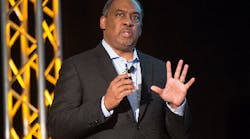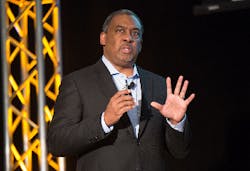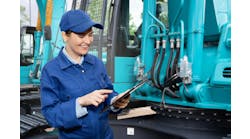Digital twin to enable asset optimization
“The digital twin is creating the cloud-based data economy.” GE’s Colin Parris explained how software-based twins of physical assets will allow industrial users to optimize performance and minimize lifecycle costs.
Amazon, Apple and Google have successfully leveraged Internet technologies and an in-depth knowledge of their customers to create tens of billions of dollars of value in a very short time. And if Colin Parris has his way, GE will soon do the same in the industrial space. But the gold to be mined in the industrial space isn’t data about individual people, it’s data about individual industrial assets, Parris, vice president of research for GE Software, told attendees of his keynote address at Smart Industry 2015.
“We look at the life of the asset to create a psychographic model, a model of one,” Parris explained. This model, or digital twin, consists of engineering models combined with machine-specific data and allows the development of per-asset analytics and ultimately an individualized profit-and-loss (P&L) relationship unique to each asset, Parris said. Clearly, GE intends to build the infrastructure that will facilitate the new products and new revenue created to serve these assets, just as Apple, Amazon and Google facilitate fulfillment of our needs as individuals.
“Apple, for example, went from $8 billion in revenue in 2004 to $183 billion in 2014,” Parris explained. “They went from music to entertainment, from entertainment to playlists, from playlists to apps, from apps to home, from home to health.” They started with a demographic profile, then added data to create a psychographic profile. Next, they use applications to drive business outcome, Parris said. “They use segmentation to start, then go from a model of one to a P&L of one. And when you put it on a platform, it’s cheap and easy to add other products.”
Want more on digital twin? Network with experts at Smart Industry 2018 IIoT conference. Learn more here.
Creating the cloud-based economy
In an industrial setting, “the digital twin is a set of continuously updated models that deliver asset insight relative to a specific business objective,” continued Parris. This translates to operational optimization of individual assets. For example, GE has used the digital-twin concept to reduce maintenance costs on its GE90 aircraft engine. “Data gathered during each flight allows us to predict the cumulative damage,” Parris said, “so I don’t need to take the engine out of service for inspection.”
“If I have the data on the exact environment that the asset is operating in,” Parris enticed, “I can de-risk the performance I give.”
GE also partnered with Infosys to create an asset-efficiency testbed, which fostered a landing-gear digital twin to reduce unscheduled downtime, improve maintenance scheduling and enhance customer satisfaction. “More than 20 sensors are used for early identification of eight failure modes,” explained Parris.
“The digital twin is creating the cloud-based data economy,” said Parris. “Let’s say we’ve built the twin capability; then you have that data that says here’s how I operate to maximize my output and minimize my cost. Dynamic teams of cooperative machines with similar operational or financial objectives can generate and share content on their current and optimal states.”
Social media for machines
Think of the way content posted on Twitter or LinkedIn or Facebook invite or entice others to post comments or additional remarks on that original post. Can machines also generate content that attracts content from other machines?
For example, a piece of equipment might need to know the optimal setting for new operational modes. “Let’s say a new wind turbine needs to know about prevailing wind direction, generally 183°, plus or minus 5°,” explained Parris. Why should it not ask its neighbors? “Or it could be a failure mode inquiry. Maybe the turbine is seeing an anomaly and can ask if it’s a precursor to a failure.” Another turbine may have seen the same anomaly, then experienced a blade rupture two days later. “In the world of machines, you can do the same thing as you do in business.”
“But industrial analytics are different,” cautioned Parris. “There’s model generation and automation, and there’s knowledge extraction. You have to know the semantics and create a taxonomy. It’s all different. When are these parts used? Why are they used? How are they used?”
The digital twin also includes data gathered through an asset’s lifecycle, from design to manufacture through service. “In the data economy, I know exactly what to tell my engineers to design,” Parris said. “They’ve got to figure out how to manufacture it on time, with a reduced cycle, in the right quality and differentiation.”
Parris also described the development of an industrial “app store,” where core and third-party applications can be combined to create manufacturing processes, and ecosystem participants collaborate through a Digital Manufacturing Commons (see related article).
“This is a very different time for us all—the tools are building better tools,” Parris said. “As costs continue to come down, it will increase what I can do in terms of simulation and innovation. We have to figure out how to use this industrial strength Internet to deliver billions in value and drive a whole new economy.”




